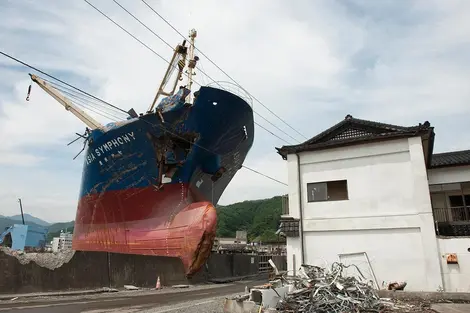A day on the shores of Kamaishi 釜石市 の海岸

Port of Kamaishi
Wikimedia
A city protected by the deity Kannon
Located in the north of Japan, Kamaishi is a rare pearl nestled between the mountains and the sea. Extending Sanriku Bay which combines the coasts of Iwate, Aomori and Miyagi prefectures, this small port city is not only renowned throughout the country for its steel industry, but also offers magnificent landscapes which will host the 2019 Rugby World Cup™. Discovery of some of its hidden treasures.
KamaishiDaikannon
Overlooking Kamaishi Bay from a height of 48.5 meters , this giant statue of the Buddhist deity Kannon offers a spectacular view of the coast .
Completed in 1970, it now has 13 floors which alternately house prayer rooms and souvenir shops.
To read: Kamaishi, city of the steel industry

Kamaishi Daikannon
www.city.kamaishi.iwate.jp
But it is above all its unique architecture that attracts the attention of tourists.
Indeed, the base of the statue consists of a temple whose pagoda was built in the Sri Lankan Buddhist style . A small touch of originality that can also be found at the top of the statue which holds a fish in its hands. Housing the observatory, the latter reminds us that Kannon watches over the bay and brings protection and good fortune to the fishermen who work at its feet.
Practical information :
Address : 3 Chome-9-1 Odairacho, Kamaishi, Iwate Prefecture 026-0002
Hours : 9am-5pm (last admission 4.30pm)
Price : adult 500yen (3€75), child 100 yen (0€75)
Access : Bus from Kamaishi JR station to Kannon Iriguchi stop
Port of Kamaishi
Built in 1874 under the order of the local lord to boost the iron trade in the region, the port of Kamaishi is still in operation today.
Welcoming about ten large cargo ships every day, this small port remains a strategic location for maritime trade.
Protected by the shadow of the deity Kannon, it is also surrounded by three Shinto shrines . A divine protection which has enabled it to withstand three tsunamis in less than a century : in 1896 , in 1933 and more recently in 2011 , which still seriously damaged its infrastructure.
Today, some areas are still under reconstruction . Despite everything, the port remains open to the public and it is always possible to admire the work of the fishermen who bring the bay to life.
Hakozaki Peninsula
With direct access to the sea, the Hakozaki peninsula was a strategic place at the time Edo ( 1603-1868 ) . For maritime trade first of all, with its routes making it possible to transport goods to the capital, then for military strategy, during the civil war opposing the shogunate to the forces of the Emperor (1868-1869), with its remote areas allowing to shelter ships during the assaults towards Sanriku Bay.
Today, it is renowned for its landscapes!
Connecting the bays of Otsuchi and Yamada in the north to that of Kamaishi in the south , the Hakozaki peninsula offers a beautiful view of the Pacific Ocean . With its coasts made of rock, it is therefore the perfect place for a walk by the sea. !
See also: Japan on the beach
The Sennin Valley
Overlooking the bay, the Sennin Mountains form a valley between the towns of Kamaishi and Tono . Famous in the region for hosting the Kamaishi marathon , this valley is also very popular with the Japanese for its pretty purple colors in autumn .
See also: Culinary specialties of Iwate Prefecture
Mount Goyo
From the top of its 1351 meters , Mount Goyo overlooks the bay of Sanriku. Rich in encypress, it once played a major role in the daily life of the inhabitants of Kamaishi who used its wood to build homes and for heating.
Now, it is a popular tourist spot for the Japanese for its fauna and flora . Home to several hundred plant species, it is also the natural habitat of several species of deer and monkeys . A good walker can reach his peak by two hours .

The valleys of Mount Goyo
Wikimedia

























